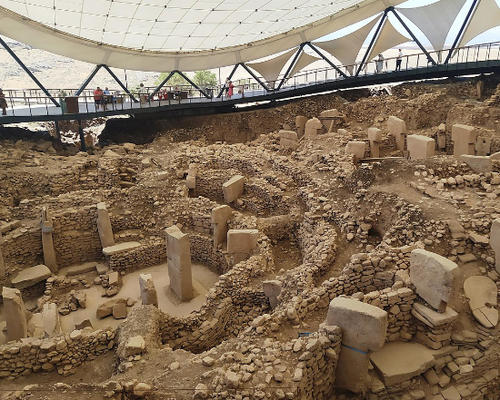Geomorphology and early human life II
Göbekli Tepe (Turkey)
Image Credit: Radosław Botev CC BY 3.0 PL
What traces of human activity on the environment are preserved and what can they tell us about our living environment? To this end, investigations were carried out on deposits in the region around Göbekli Tepe, one of the oldest known human settlements in early Earth history. Traces can be traced here back to the early Preceramic Neolithic A (ca. 10,000 BC). The area in south-eastern Turkey is characterised by mountain ranges, whose steep highlands and wide foothill zones as well as nearby floodplains expose diverse sedimentary environments. The aim of the analysis is to better understand geomorphological activity in the interplay of climatic and anthropogenic influences.
The data
The dataset from the vicinity of Göbekli Tepe comprises a total of 42 14C ages obtained from 14 sediment profiles. The dataset also contains a description for the calculation of the cumulative probability functions used in the study.
Publication of the data set: Nykamp, M et al (2021) https://doi.org/10.1002/esp.5035 (see: Supporting Information)
Research results
By applying the cumulative 14C probability functions and considering the sediment cascade model, it could be shown that particularly strong geomorphological changes have taken place within two time periods.
Geomorphological activity maxima of 7.4 - 7.0 and 5.8 - 3.3 millennia BC coincide with population increases and the onset of agricultural cultivation. The identified periods are also consistent with the general trend of changing geomorphodynamic activity in the eastern Mediterranean due to human influences and climatic changes. However, neither the transition from the Younger Dryas to the Holocene nor the development of livestock farming during the Neolithic have left a clear signature. Future, more comprehensive dating with better spatiotemporal resolution should capture the separate influence of climatic or anthropogenic factors. In this study, both factors are still dynamically intertwined and do not allow a precise assignment in individual cases.
Publication of the journal article: Nykamp, M et al (2021) https://doi.org/10.1002/esp.5035
Texts modified after: Nykamp, M et al (2021) https://doi.org/10.1002/esp.503
